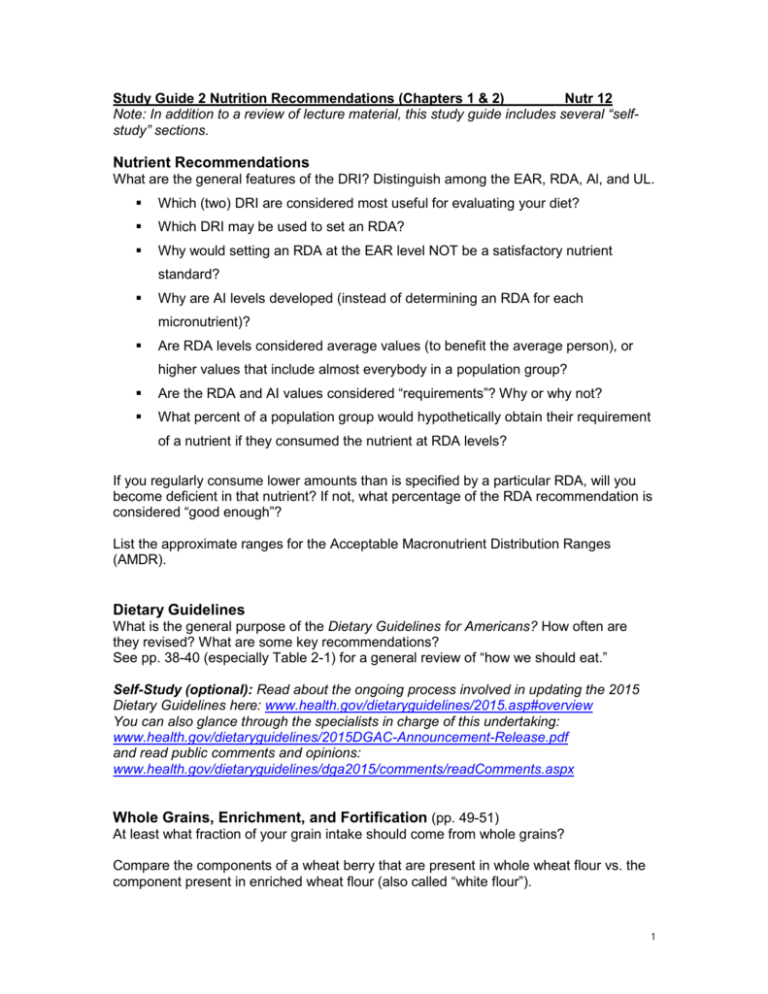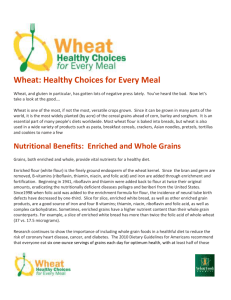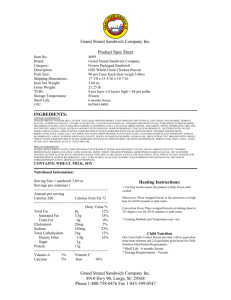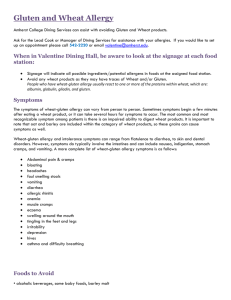Study Guide 2 - Fog.ccsf.edu
advertisement

Study Guide 2 Nutrition Recommendations (Chapters 1 & 2) Nutr 12 Note: In addition to a review of lecture material, this study guide includes several “selfstudy” sections. Nutrient Recommendations What are the general features of the DRI? Distinguish among the EAR, RDA, Al, and UL. Which (two) DRI are considered most useful for evaluating your diet? Which DRI may be used to set an RDA? Why would setting an RDA at the EAR level NOT be a satisfactory nutrient standard? Why are AI levels developed (instead of determining an RDA for each micronutrient)? Are RDA levels considered average values (to benefit the average person), or higher values that include almost everybody in a population group? Are the RDA and AI values considered “requirements”? Why or why not? What percent of a population group would hypothetically obtain their requirement of a nutrient if they consumed the nutrient at RDA levels? If you regularly consume lower amounts than is specified by a particular RDA, will you become deficient in that nutrient? If not, what percentage of the RDA recommendation is considered “good enough”? List the approximate ranges for the Acceptable Macronutrient Distribution Ranges (AMDR). Dietary Guidelines What is the general purpose of the Dietary Guidelines for Americans? How often are they revised? What are some key recommendations? See pp. 38-40 (especially Table 2-1) for a general review of “how we should eat.” Self-Study (optional): Read about the ongoing process involved in updating the 2015 Dietary Guidelines here: www.health.gov/dietaryguidelines/2015.asp#overview You can also glance through the specialists in charge of this undertaking: www.health.gov/dietaryguidelines/2015DGAC-Announcement-Release.pdf and read public comments and opinions: www.health.gov/dietaryguidelines/dga2015/comments/readComments.aspx Whole Grains, Enrichment, and Fortification (pp. 49-51) At least what fraction of your grain intake should come from whole grains? Compare the components of a wheat berry that are present in whole wheat flour vs. the component present in enriched wheat flour (also called “white flour”). 1 Suppose the first ingredient on a bread label is “enriched wheat flour.” Would the product more likely be a whole grain product or a refined grain product? In a mostly “whole wheat” bread or cereal product, which ingredient should be listed first? Which five nutrients are replaced in “enriched” food products? Compare the nutrient density of whole wheat bread and enriched wheat (white) bread. (Note that the term refined grain is used when only a portion of a grain is used in a product, so white flour and white bread are considered refined grain products.) Self-study: As Figure 2-7 (p. 51) shows, the content of “enriched” nutrients is similar in whole grains and enriched products, but other nutrients are much lower in the enriched products. Therefore, the term “enriched” may imply a benefit that is not necessarily as favorable as the average consumer may expect. Compare the terms “enriched” and "fortified." Find and circle the fortified food products on the list below; note that you should be able to circle four of the products listed: Iodized salt Doughnuts Dinner rolls (made with enriched wheat flour) Whole wheat bread Nonfat milk with added vitamins A and D Chocolate-chip cookies Orange juice with calcium White bread (made with enriched wheat flour) Total cereal (meets 100% of the DV for most vitamins and minerals Shredded Wheat cereal (Ingredients: whole wheat) “Choose My Plate” Food Guide Self-Study: You can learn about your energy needs and find a personalized eating plan at www.choosemyplate.gov. Most of the interactive tools can be found by clicking “SuperTracker and Other Tools” on the green menu bar. The “Daily Food Plan” option allows you to obtain a food plan (see www.choosemyplate.gov/myplate/index.aspx), and the “SuperTracker” allows the analysis of your diet and/or physical activity. Note: The food plans used by the Choose My Plate application are described in Tables 2-2, 2-3, and 2-4 on p. 44. Review pp. 40-46 in the textbook to help answer these questions: How does the “my plate” icon (Figure 2-4, p. 46) help people visualize the types and amounts of foods they should eat? Name the five types of food groups and the relative proportions suggested by the image. Check your (or another person’s) food plan (see tables on p. 44) to answer these questions: 2 o Note that portion sizes for fruits and vegetables are expressed in terms of cup measurements. How does the term “cup” help the user (instead of using the term “serving”, for example)? o Note that meat and other protein foods are expressed in ounces. About how big is a 3-oz portion of meat? o Explain why the vegetable group has been broken down into subgroups. Name the 5 vegetable subgroups (Table 2-4). o Note the suggested limit for calories from solid fats and added sugars (see Table 2-2 for Discretionary kCalories). Check to see how many of these calories you are limited to daily. What types of foods and food components are included in this category? Food Labels (pp. 53-58) Which government agency is in charge of food labels on most foods? (Note that the agency in charge of MEAT AND POULTRY labeling is the U.S. Department of Agriculture.) List the types of information that must appear on food labels (pp. 53-55). How are ingredients listed on food labels? Are sugars grouped together, or listed separately? Check the nutrient list on the Nutrition Facts panel (Figure 2-8). • Does the sugar listing pertain to natural sugars, added sugars, or both? • Which 4 vitamins and minerals must be included on all Facts panels? Serving sizes are standardized for all foods. Why is this policy helpful for the consumer? (p. 54) Daily Values: Reference standards used for nutrient comparison are called "Daily Values" (DV). • What exactly does it mean if a food serving provides 3% of the DV for Saturated Fat, or 2% of the DV for Dietary Fiber? (p. 55-56) • Where are the reference values for DVs located? (i.e., 3% what value?) • Which caloric intake is the standard for the "% Daily Values" column on food labels? How can people with caloric intakes other than 2000 Calories get information that pertains to their intake? Descriptive terms: Read the list of terms in the table on p. 57. This is only a partial list – other terms have legal definitions, as well. Compare the definitions for a “good source” and “low source” of a nutrient. Compare the helpfulness of the terms “low”, “less”, and “reduced” (low fat vs. reduced fat, for example) 3









